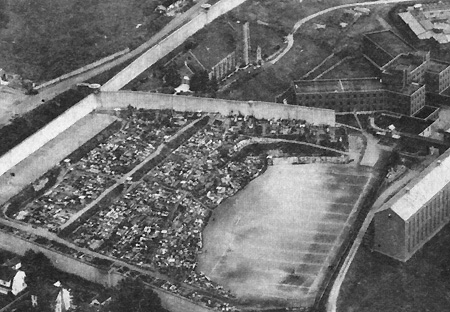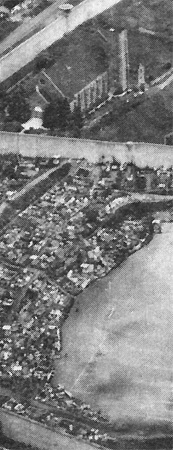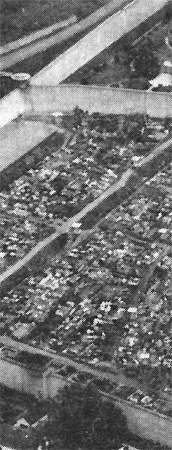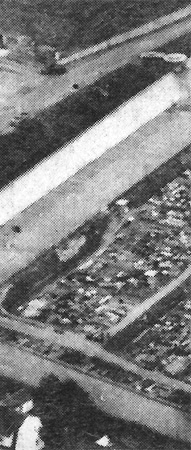
Recreation yard detail from aerial view of Clinton Correctional Facility in 1972 report.
(part 2: social organization) |
||||||
|
by Ron Roizen The courts occupy a "social" space. They define a system of social relationships within the courts, as well as a system of social relationships linking the courts to the institution as a whole. First, they are used by a limited number of people for limited amounts of time and for limited kinds of available activities. They also manifest a simple organizational structure. Discussion [of] these limits will give use some idea of the dimensions of the social cubicle that the courts constitute.
The courts are open between 3:10 and 4:30 pm on weekdays; on weekends and holidays, they are open from 8:00 am to 4:30 pm. Bad weather or prison wide disciplinary action may also close the courts temporarily. On weekends, these activities may be substituted by movies or religious services.
Not every inmate has a court; indeed, not every inmate may use the recreation yard. Without having made a census of the various functional or activity alternatives to the courts, it is impossible to put precise numbers on the various subpopulations. Nevertheless, let us begin by reviewing who uses the yard. Recreation in the yard is part of the daily routine of Clinton prison.
Ill and newly-arrived inmates are exercised separately, in the smaller courts between buildings or not exercised. A separate lawn behind the hospital is for men with tuberculosis and other communicable diseases. Men working on gangs, work crews that go outside the wall, do not use the yard when they are so working. In all, therefore, a sizeable proportion of the inmate population does not use the yard -- roughly 1200 men make up the yard population on an average afternoon. In round numbers, that constitutes about two-thirds of the inmate population. Some men simply prefer to stay in their cells during these times. Access to the yard is not synonymous with access to the courts. Several kinds of activities exist on the yard, and, for the most part, these define relatively permanent groups rather than merely a menu of available diversions. Involvement in a rigorous sport, for example, is seen as an alternative to membership in the courts rather than an adjunct to it. Once again, it is difficult to estimate the sizes of the various subpopulations of the yard. Nevertheless, the following groups appeared to me to have significant numbers of participants:
Our guess is that no more than half of the yard population belongs to courts. The de facto user population is probably somewhat less than that. Mancusi's 1957 study of the courts reported that 63% of the inmate population were court members; we guess that that proportion has declined. In any case, the courts are not the quasi - residential bases for either all of the members of the inmate population or for all of the yard users. The exclusiveness of these activities is not absolute -- thus, a football player may "visit" a friend in one of the courts (although the reverse is more difficult, I imagine). Likewise, we should be cognizant that the courts are in some sense a select population, arrived at by something of a screening process. There are several ways for an inmate or a group of inmates to get a court if one is desired. Perhaps the most common one is through friendship with an inmate who is already on a court. An inmate may befriend another or re-establish a friendship tie that existed on the outside (this may not necessarily be a friendship tie: inmates may look out for men with similar interests, similar group associations, similar political or religious beliefs, similar educations, kinship relations or the kin of kinship groups, etc.) In any case, the "applicant" is suggested to the inmate "manager" of the court, who has the final say on the making of invitations to join the court. In practice, this "say" is not often a formal matter -- it is informally given or withheld within the framework of day-to-day interaction in the court. A potential member may be scrutinized by the manager and other members of the court. Rodehaver, Mancusi, and Smith (1964), in their article on the courts, reported that homosexuals, sex offenders, belligerent men, and shirkers were avoided. Preference goes to individuals who either fit in with the dominant activities of a particular court or whose connections on the inside or on the outside enhance the welfare of the fellow court members. Thus men who have access to valued information, goods, or services are desirable members. A man must also be thought to be willing to share the court's work--for example, stand in line when the wood-fuel is disbursed.
A second avenue to court membership is somewhat more formal. Rather than approaching a particular court, an inmate or several inmates put their names on a waiting list. If a court becomes available by dint of the departure of all of its members, or disciplinary action against them or some other reason, the new list of names is given the court. I am not entirely clear on the capacity of sergeants to suggest that certain courts take on certain members, but it seems that this is not done. The yard sergeant has only veto power. There is, however, a norm regarding the toleration of depopulating or depopulated courts. Managers whose courts have not maintained a membership size that is up to capacity may often be warned by the sergeant that they should expand their membership or risk having the court handed over to a new group. In this way, the ability of the courts to absorb a larger proportion of those desiring courts is enhanced. |
| <-- previous | [parts list] | next ---> |


